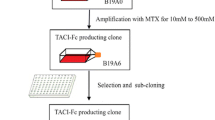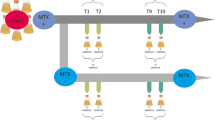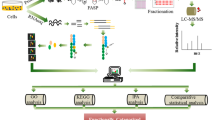Abstract
Ammonium is a toxic waste product that has been reported to negatively inhibit cell growth and recombinant glycosylation in Chinese hamster ovary (CHO) cells; however, the effect of this toxicity on intracellular gene expression has received only limited investigation. We used a differential display method to identify genes in CHO cells that were affected by ammonium stress. Eight genes whose mRNA levels significantly changed in response to elevated ammonium were isolated and identified. Five of the genes were identified as having lower expression under the ammonium stress, whereas three genes were identified as having higher expression. Sequence homology with other mammalian organisms was used to attribute function to these newly identified genes. The identified ammonium-sensitive genes were grouped into three broad functional groups: cellular processes, energy metabolism, and genetic-information processing. The three cellular process-related genes had lower expression (anaphase-promoting complex subunit 5, eukaryotic initiation factor 5A II, KIAA1091 protein). The two energy-related genes had higher expression under ammonium stress (adenosine triphosphate synthase subunit C and mitofusin 1). Both of the genetic information-processing genes (endoplasmic reticulum [ER]-resident protein ERdj5 and structure-specific recognition protein 1) had lower expression under the ammonium stress, whereas the 26S proteasome subunit adenosine triphosphatase 3 gene had higher expression. These preliminary results indicate that ammonium stress lowers expression of genes controlling cell cycle, protein folding, and quality and raises genes that control energy metabolism and degradation. Our findings demonstrate the usefulness of mRNA differential-display techniques for the detection of CHO cell genes affected by ammonium stress.
Similar content being viewed by others
References
Jenkins, N., Parekh, R. B., and James, D. C. (1996),Nat. Biotechnol. 14, 975–981.
Ozturk, S. S., Riley, M. R., and Palsson, B. O. (1992),Biotechnol. Prog. 6, 121–128.
Glacken, M. W., Fleischaker, R. J., and Sinskey, A. J. (1986),Biotechnol. Bioeng. 28, 1376–1389.
Miller, W. M., Blanch, H. W., and Wilke, C. R. (1988),Biotechnol. Bioeng. 32, 947–965.
Chen, P. F. and Harcum, S. W. (2005),J. Biotechnol. 117, 277–286.
Gawlitzek, M., Papac, D. I., Sliwkowski, M. B., and Ryll, T. (1999),Glycobiology 9, 125–131.
Schneider, M., El Alaoui, M., von Stockar, U., and Marison, I. W. (1997),Enzyme Microb. Technol. 20, 268–276.
Yang, M. and Butler, M. (2000),Biotechnol. Bioeng. 68, 370–380.
Hansen, H. A. and Emborg, C. (1994),Biotechnol. Prog. 10, 121–124.
Reuveny, S., Velez, D., Macmillan, J. D., and Miller, L. (1986),J. Immunol. Methods 86, 53–59.
Yang, M. and Butler, M. (2000),Cytotechnology 34, 83–99.
Yang, M. and Butler, M. (2002),Biotechnol. Prog. 18, 129–138.
Jenkins, N. (1996),Curr. Opin. Biotechnol. 7, 205–209.
Boron, W. F. and De Weer, P. (1976),J. Gen. Physiol. 67, 91–112.
Knepper, M. A., Packer, R., and Good, D. W. (1989),Physiol. Rev. 69, 179–249.
Kikeri, D., Sun, A., Zeidel, M. L., and Hebert, S. C. (1989),Nature 339, 478–480.
Liang, P. and Pardee, A. B. (1992),Science 257, 967–971.
Ko, J. et al. (2003),Oncogene 22, 4679–4689.
Butowt, R., Granot, D., and Rodriguez-Garcia, M. I. (2003),Plant Cell Physiol. 44, 1152–1161.
Moore, R. C. et al. (2003),Genetics 163, 321–334.
Leng, R. P. et al. (2003),Cell 112, 779–791.
Liang, P. et al. (1994),Nucleic Acids Res. 22, 5763, 5764.
Molhoj, M., Johansen, B., Ulvskov, P., and Borkhardt, B. (2001),Plant Mol. Biol. 45, 93–105.
Altschul, S. F. et al. (1997),Nucleic Acids Res. 25, 3389–3402.
Lang, P., Zhang, C.-K., Ebel, R. C., Dane, F., and Dozier, W. A. (2005),Gene 359, 111–118.
Kanehisa, M. (1997),Trends Genet. 13, 375, 376.
Kanehisa, M. and Goto, S. (2000),Nucleic Acids Res. 28, 27–30.
Autieri, M. V. (2001),Biochem. Biophys. Res. Commun. 282, 723–728.
Jenkins, Z. A., Haag, P. G., and Johansson, H. E. (2001),Genomics 71, 101–109.
Park, M. H., Wolff, E. C., and Folk, J. E. (1993),Trends Biochem. Sci. 18, 475–479.
Nakayama, M., Kikuno, R., and Ohara, O. (2002),Genome Res. 12, 1773–1784.
Schneider, M., Marison, I. W., and von Stockar, U. (1996),J. Biotechnol. 46, 161–185.
Martinelle, K. and Haggstrom, L. (1993),J. Biotechnol. 30, 339–350.
Glacken, M. W. (1988),Bio/Technology 6, 1041–1050.
Tipton, K. F. and Couee, I. (1988), inGlutamine and Glutamate in Mammals, vol. 1, Kvamme, E., ed., CRC Press, Boca Raton, FL.
Glacken, M. W., Adema, E., and Sinskey, A. J. (1988), „Mathematical Descriptions of Hybridoma Culture Kinetics II. The Relationship between Thiol Chemistry and the Degradation of Serum Activity„ (Rice University, 1988).
Zhou, W. C., Chen, C. C., Buckland, B., and Aunins, J. (1997),55, 783–792.
Santel, A. et al. (2003),J. Cell Sci. 116, 2763–2774.
Fritz, S., Rapaport, D., Klanner, E., Neupert, W., and Westermann, B. (2001),J. Cell Biol. 152, 683–692.
Rapaport, D., Brunner, M., Neupert, W., and Westermann, B. (1998),J. Biol. Chem. 273, 20,150–20,155.
Rojo, M., Legros, F., Chateau, D., and Lombes, A. (2002),J. Cell Sci. 115, 1663–1674.
Andersen, D. C. and Goochee, C. F. (1995),Biotechnol. Bioeng. 47, 96–105.
Cunnea, P. M. et al. (2003),J. Biol. Chem. 278, 1059–1066.
Hosoda, A., Kimata, Y., Tsuru, A., and Kohno, K. (2003),J. Biol. Chem. 278, 2669–2676.
Nagulapalli, S., Pongubala, J. M. R., and Atchison, M. L. (1995),J. Immunol. 155, 4330–4338.
Spencer, J. A., Baron, M. H., and Olson, E. N. (1999),J. Biol. Chem. 274, 15,686–15,693.
Cao, S. et al. (2003),Mol. Cell. Biol. 23, 5301–5307.
Carlone, D. L. and Skalnik, D. G. (2001),Mol. Cell. Biol. 21, 7601–7606.
Herceg, Z. et al. (2001),Nat. Genet. 29, 206–211.
Tanaka, K. (1995),Mol. Biol. Rep. 21, 21–26.
Gottesman, S. (2003),Annu. Rev. Cell Dev. Biol. 19, 565–587.
Xiong, X. M., Chong, E., and Skach, W. R. (1999),J. Biol. Chem. 274, 2616–2624.
Kopito, R. R. (1997),Cell 88, 427–430.
Author information
Authors and Affiliations
Corresponding author
Rights and permissions
About this article
Cite this article
Chen, P., Harcum, S.W. Differential display identifies genes in chinese hamster ovary cells sensitive to elevated ammonium. Appl Biochem Biotechnol 141, 349–359 (2007). https://doi.org/10.1007/BF02729072
Received:
Revised:
Accepted:
Issue Date:
DOI: https://doi.org/10.1007/BF02729072




